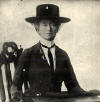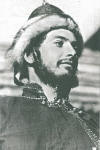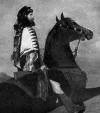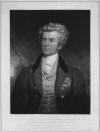Ann Bailey - made many Long Rides in Virginia during the late 18th century on her horse "Liverpool."
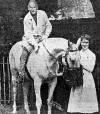
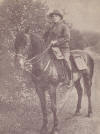
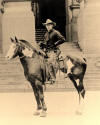
George Beck –
led the Overland Westerners on an amazing 20,000 mile journey to all 48
state capitals in the USA. Beck’s remarkable journey began in 1912, when he
convinced his brother Charlie, his brother-in-law, Jay Ransom, and a friend,
Raymond Rayne, to join him on a cross-country horse trip which he believed
would bring them all fortune and fame. Despite calling themselves the
Overland Westerners, the four
former loggers had no equestrian travel experience. Nevertheless they
set off on the
May 1, 1912 from their hometown of Shelton, Washington. Their first
destination was Olympia, the nearby state capital.
There they had their photograph taken with the governor and received an
official document known as a “Certificate of Call” which confirmed their
arrival at that city. For the next three years Beck led the Overland
Westerners through a long series of ordeals. They rode through every type of
bad weathers, crossed every geographic challenge and survived terrible
economic hardship in their quest to be the first persons in history to ride
to all 48 American state capitals.
They reached Sacramento, their 48th and last state capital on May 24, 1915. They had been in the saddle for three years and one month, a record 1127 days of that time spent riding. They had gone through 17 horses on the 20,352 mile trip. During this time the men had spent just $9,000 between them.
After their photograph was taken with the governor of California, Beck led the Overland Westerners towards their last stop, the Panama Pacific International Exposition in San Francisco. Arriving there on June 1, 1915, the men had expected to be greeted as heroes by the boisterous crowds gathered there to celebrate the opening of the Panama Canal. Instead an Irish cop yelled at them to “get them hayburners off the street.” Little Sheba the belly-dancer was big news. Four saddle-sore heroes were not. They came expecting glory. They found only financial failure.
Within days their story and marvellous achievement was rapidly forgotten by an apathetic public more interested in the outbreak of World War One than four weary men and their footsore horses. George Beck’s three companions, tired, broke and broken-hearted, sold their horses and tack and rode the rails home to Washington. George stayed on in San Francisco trying to coax a story out of editors and authors. Jack London, among others, turned him down. With no hope and no pot of gold, George managed to pull off his last miracle. He saved his horse.
Pinto was the only mount who had managed to complete the entire gruelling trip. The tough little 15 hand, 900 pound Morab gelding had started the journey as the humble pack horse. But he soon left his pack saddle behind and become George’s equine soul-mate. Beck scraped together enough money to get him and the ever-loyal Pinto passage home on a tramp steamer. They arrived back in Puget Sound to no fanfare. Beck tried to put his recollections into a book but had no success.
“I wrote it sweet enough but it came
up sour,” he said.
That brief statement could have summarized his life and great adventure.
Beck, the man who had saddled his dream and rode it out, died one night dead
drunk, drowned in a six-inch deep roadside ditch. Soon after his master’s
death, Pinto was sent off to labour one last time, lugging a packsaddle once
again, through the thick, rainy depths of the Olympic National Forest. Pinto
was never heard of again.
After that all trace of the Overland Westerners soon disappeared.
In 1925 a former US Cavalry man, Frank Heath, set out to ride to the edge of all 48 states. After he completed his 11,000 mile journey, Heath wrote an important book entitled “Forty Million Hoofbeats.” He did not record encountering anyone who met or remembered Beck and his companions. It was not until 1998, when a detailed account of their journey was released, that the astonishing story of the Overland Westerners was rescued from oblivion.
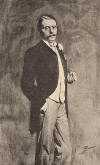
English artist
Julius Beerbohm’s role in equestrian travel history was overshadowed for
nearly a hundred years by that of his famous companion, English Long Rider
Lady Florence Dixie.
Thanks to his connections to the English aristocracy, Beerbohm could afford to accept the invitation offered by Lord and Lady Dixie when they announced they intended to explore the wilds of Patagonia on horseback. The group arrived at the sparsely populated tip of South America in 1877, obtained horses and a local guide, then wasted no time before setting off to explore the interior.
The journey required the aristocrats to leave behind any traces of their former soft life. They rode hundreds of miles, barely survived a wild prairie fire that threatened to burn them alive in the saddle, dined on an assortment of strange local cuisines, befriended the mounted Indians and returned to England a year later full of adventurous tales.
Lady Florence Dixie quickly wrote, “Riding Across Patagonia,” a popular account of her travels which she shared with fellow Long Rider, Charles Darwin.
What has been overlooked until recently was that it was the talented Julius Beerbohm who not only illustrated Lady Florence’s book, he also wrote and illustrated his own version of events in a book entitled, “Wanderings in Patagonia; or, Life among the Ostrich Hunters.” Beerbohm’s book recalls how he rode across vast stretches of wild country, barely survived treacherous river crossings and escaped a local mutiny launched by escaped prisoners.
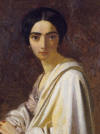
Princess Cristina Trivulzio di Belgiojoso
was an Italian noblewoman, writer, political revolutionary, social reformer
and equestrian traveller who rode from Turkey to the Holy Land.
Described as the richest heiress in Italy, at sixteen she was wed to a libertine prince. After their separation she became an ardent supporter of Italy’s struggle for independence from the Austro-Hungarian empire. Her political activities brought her to the attention of the secret police, which forced her to flee to France. During the 1830s and 1840s her Paris salon became a meeting place for Italian revolutionaries. She also associated with the European artistic intelligentsia, including Honore de Balzac, Victor Hugo and Franz Listz.
In 1838, she gave birth to a daughter, she named Mary. Yet motherhood did not suppress her political ardour. During the Italian revolution of 1848 she organized her own troop of soldiers, the led them into battle against the Austrians. When that insurrection failed, she returned to Paris where she published articles describing Italy’s plight. . In 1849 she returned to Italy to support another independence movement but when it too failed, she was forced to flee with her daughter, and her English maid, Mrs. Parker.
They ended up in Turkey, where the Princess purchased a remote farm two days ride from Ankara.
In January 1852, the adventuresome trio left for an eleven month equestrian journey which took them through Turkey, Syria and Palestine. Due to Cristina’s desire to learn about the people, their culture and religion, she visited harems, administered medicines, and interviewed various officials, all the while putting up with the hardships of mounted winter travel. An avid author, the Princess published an account of her experiences. In her book, Of Women's Condition and of their Future, she took great exception to how women were treated in this part of the world, arguing that to deprive girls of education was to condemn women to lives of oppression.
After eight years in exile, Princess Cristina returned to Italy in 1856. She spent her final years writing, assisted by her Turkish servant, a former slave.
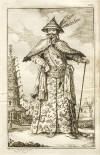
[This image does not actually portray the Historical Long Rider. It appears in the Dutch translation of Bell's book. The Guild continues to search for an image depicting the Long Rider and will publish it when found.]
The world of equestrian travel seldom recognizes international borders, being content to urge its mounted adherents to ride where they will. Few people better symbolize this ancient philosophy of unrestricted freedom than Ana Beker. The only child of Lithuanians who had immigrated to Argentina, Beker grew up surrounded by horses on the vast, wind-swept pampas. Her earliest memories were centred around these four legged friends. She literally grew up in the saddle, ignoring the traditions of the male oriented society which said that a woman’s place was by the hearth, not in the saddle. History might have been content to let her stay in her homeland, until a fateful meeting changed her fate forever. In the early 1940s Beker heard a lecture given by Aimé Tschiffely, who had himself ridden from Argentina to Washington DC ten years earlier. When the famous horseman scoffed at the young girl’s idea to ride alone even further than he had, from Argentina to Canada, Beker accepted Tschiffely’s challenge, mounted up, and never looked back. What followed was an equestrian journey of Homeric proportions. With her eyes always on the horizon, Beker began a 17,000 mile mounted odyssey that would fix her place in the annals of equestrian travel history. Her book, The Courage to Ride, is thus not only a thrilling adventure tale, it is also a true account of a wild heart that would not be conquered.
The Long Riders' Guild were thrilled to receive an email from Suzanne Copenhagen, who wrote to say that she recalled Ana riding into her parents' front yard in 1954 to seek shelter for the night!
"I was not quite six years old when Ana Beker stayed overnight at our house outside Sandy Spring, Maryland, while her two horses enjoyed the hospitality of our barn," Suzanne wrote. To read Suzanne's charming recollections of meeting this legendary Long Rider, please click here.
To read an excerpt from Ana's book, in which Ana writes about how giant condors tried to kill her horses in the Andes mountains, please click here.

In addition to being probably the best known side-saddle rider of her day, Irene Benjamin was also a determined Long Rider. After a near fatal riding accident which left her partially paralysed, Irene was told she would never walk again. Determined to prove the doctors wrong, Irene not only eventually got back into the saddle, she gave mounted displays all over the world and undertook extended equestrian journeys in America and Australia. In 1998 Irene set out to ride from Glasgow, Scotland to Surrey, England in order to raise money for the Rare Breeds Survival Trust. Having recently survived cancer chemotherapy treatment, many advised this extraordinary woman not to attempt the journey. Irene was determined not to succumb to either disease or dissent. She set off on the 1250 mile ride full of determination and courage. Sadly, a few days into the journey Irene fell ill with pneumonia and was taken to hospital, where she died nine days later. In honour of her extraordinary courage, the International Side Saddle Organization instituted an annual “Irene Benjamin Handicapped Rider Award.”
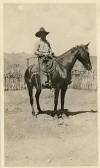
Frank Bessac – took part in one of the most extraordinary equestrian journeys of the 20th century, an ill-fated journey which took him from the borders of Mongolia to the distant Tibetan capital of Lhasa.
After learning Chinese in university, Bessac was recruited by the Office of Strategic Services (OSS), the forerunner of the CIA. In 1945 he was dispatched to the border area between China and Mongolia. While there Bessec was befriended by Prince De, a descendant of Genghis Khan. In 1948 Bessac assisted Prince De in distributing vitally needed food aid sent to the Mongols by the US State Department. In recognition Bessac was made a Knight of Genghis Khan and named an honorary Mongol. With China descending into political chaos, Bessac then travelled to the remote western city of Urumchi. There he met fellow American Doug Mackierrnan, the American vice-consul who was working as a secret agent of the CIA. With their retreat to the East cut off by advancing Chinese Communist forces, Bessac agreed to join Mackiernan and three White Russian refugees who were determined to escape. The plan was to travel overland to meet Osman Bator, the leader of the Kazakh nomads, obtain horses and then ride south across China, Tibet and on into India. The resultant 2,000 mile journey forced Bessac and his companions to cross almost uninhabited and unmapped territory, survive one of the world’s most deadly deserts and ascend the Himalayan Mountains before finally reaching Lhasa. Along the way they suffered hardship and death.
Having initially eluded their Chinese pursuers, when the equestrian escapees reached the Takla Makan Desert, Kazakh nomads advised the travellers that, because there was no pasture ahead, they could only proceed if they rode specially-trained, meat-eating horses. The Kazakh chief, Hussein Taiji, said that such horses were rare, and would cost twice as much. The diet of these extraordinary horses was another equine, the wild ass of Central Asia.
One of Bessac’s Russian companions, Vasili Zvansov, later recalled, “We searched for three months amongst the Kazaks for these rare meat-eating horses. But when we found them we discovered they wouldn’t eat just any kind of meat – they would only eat the liver of the wild ass, known as the Gobi Kulan. We also learned we couldn’t feed them liver every day, or it would have killed them, so we fed them every few days. There was indeed no grass on the entire trip and only the horses which ate the liver survived the trip.”
At one point Bessac was thrown from a horse and fell on the submachine gun that was strapped to his back, cracking a vertebra.
During the course of their journey McKiernan had managed to radio Washington to report their progress. The American government in turn sent word to the Dalai Lama’s government, asking the Tibetans to extend diplomatic sanctuary to McKiernan and his men when they reached Lhasa. The problem was that McKiernan and Bessac were due to enter Tibet before any official word of greeting could be sent from the capital to the distant border post. Plus, McKiernan's group had no visible sign of authority. Mistaking he travellers for bandits or communist raiders, the Tibetan border guards opened fire. McKiernan and two of the Russians were slain. Bessac and the remaining Russian, Vasili Zvansov, were wounded. The Tibetans then tied up the two survivors, threw them on their horses and began heading them towards the still distant Lhasa. Marching before the dazed Bessac was a baggage camel carrying a filthy sack. With his own life hanging by a thread the wounded American didn’t comment on what he knew was swinging back and forth before him, for his Long Rider comrade, Mackiernan, had been beheaded on his birthday. And that grisly trophy, along with the heads of the deceased Russians, led the way to Lhasa.
On June 12 1950 the two wounded travellers arrived in the Tibetan capital where they visited the Dalai Lama, then aged 14. Because Tibet was under imminent threat of invasion from the approaching Chinese People’s Liberation Army, Tibetan leaders urged Bessac to obtain American protection for the endangered country. Though Bessac insisted that he had no official status, he promised to transmit the Tibetan request for military aid to the authorities in Washington DC. After crossing rivers and more Himalayan passes, Bessac eventually reached India and then returned to the United States. Unfortunately by the time Bessac presented the Tibetans request for assistance to Secretary of State Dean Acheson in Washington, the Chinese Communists had invaded. Bessac believed that had Mackiernan lived, the experienced diplomat might have had time to convince Washington to recognise Tibet soon enough to preserve it as a sovereign state.
Soon after his return to the USA, Frank Bessac wrote an article for Life magazine entitled “Trek to Tragedy.” Before his death in 2010 Bessac provided the Long Riders’ Guild with extracts from his journal, which form this unique "Story from the Road.” He also completed a book entitled “Death on the Chang Tang: Tibet, 1950: The Education of an Anthropologist.”
There is an amazing equestrian epilogue to Bessac’s story. In 1954 National Geographic magazine documented how Kazakh chief Qali Beg led his tribe 3,000 miles from Sinkiang, China to safety in Kashmir, India. Part of the tribe’s journey was made on specially trained meat-eating horses, which were able to survive in the grassless Takla Makan desert!
Here is an excellent obituary published in Britain's Daily Telegraph.
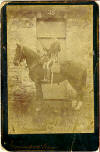
While stationed on the island
of Corfu in 1838, Captain J. J. Best decided to use his leave to
explore Albania on horseback. Consequently he set off in November of that
year to ride through the seldom-seen land. The isolated country which the
Long Rider, accompanied by his fellow English officers, Captains Murray and
Cunynghame, and Lieutenant Shaw, proposed to ride through was a province of
the Ottoman Empire and strangers were neither permitted nor welcomed.
In his book, “Excursions in Albania,” Best described how he obtained official army permission to explore the hermit kingdom of Europe. This permission was vitally important because eight months prior to this Prince Pierre Napoleon, son of Lucien Bonaparte, went into the country illegally to hunt, whereupon he and his group became involved in a lethal shoot-out with the mountainous inhabitants, the result of which was that two Albanians were killed and the entire countryside was alerted against foreigners.
English officers had been sneaking into Albania for some time to hunt without any official Albanian authorization. So Best's recognized journey was historically important as it appears he may have been the most important English traveller to explore the country since Lord Byron rode there in 1809.
Best’s book is packed with a variety of equestrian adventures. However, one piece of equestrian travel advice offered by the author is worth recalling.
"We had not resumed our journey long before we came to another river, and hearing there were many more which we must cross in our day's journey, we decided on adopting a plan which I strongly recommend to all persons who may meet with similar difficulties in travelling through a wild country with a small allowance of clothes. Sitting in wet clothes is likely to cause rheumatism, so, after some deliberation, we came to the conclusion, that in a warm climate like Albania the lower garments, which we usually wear in the civilized part of Europe, ought to be considered as useless encumbrances, and fit only for fashionables who study their personal appearances.
We therefore (do not blush, gentle reader) established a fashion of our own, and rode without any at all!
By this remarkably simple and ingenious contrivance, for which we took to ourselves a great deal of credit, we preserved a set of dry clothes to put on at the end of our day's ride, and ran no risk of getting rheumatism by keeping in wet ones. We performed a considerable part of this last part of our journey in this extraordinary costume. What a fine subject for a caricaturist! At first I was disposed to laugh a good deal, but a few hours up to my girths in water cooled astonishingly my sense of the ridiculous."
In his merry story the young English Long Rider recalled how he and his friends avoided being murdered by trigger-happy Albanians, witnessed the miseries of a local slave market and out-rode local brigands.
"This ended the equestrian part of my journey, which was the most exciting and enjoyable excursion I had ever made in my life," Best wrote.

In 1939 Nick Beucher decided he wasn’t cut out to be a salesman.
Instead the twenty-one-year-old saddled up and set off to ride from Del Rio,
Texas to Mexico City. Upon his arrival, Nick was warmly welcomed by the
mayor of the nation’s capital and his story was placed on the front page of
the local newspaper. Nick was accompanied by his friend, Tex Bunteen.
Isabella Bird (1831-1904), the daughter of a clergyman, was born in the north of England in 1831. She was a sickly child, suffering with terrible back pain. In 1871, after both her parents had died, her doctor suggested that she should travel to improve her health. Isabella sailed for Australia in October 1872, visited New Zealand and then set sail for the United States in January 1873. By chance she stopped off in Hawaii, and spent six months there riding round the islands - astride! At last, at the age of 42, Isabella had found her true calling: adventurous equestrian journeys. On Horseback in Hawaii was published as The Hawaiian Archipelago. From Hawaii Isabella went to San Francisco in August 1873 and spent the rest of that year riding around the Rockies. A Lady's Ride in the Rockies was published as Lady's Life in the Rocky Mountains. Her next journey was to Japan, where she travelled around on horseback between May and December 1878. Unbeaten Tracks in Japan was originally published in 1880. When she was almost 50 years old the legendary traveller married John Bishop, but he died in 1886. In January 1890 she travelled from Baghdad to Teheran, and then went on to the Black Sea. This resulted in her third equestrian travel book, Journeys in Persia and Kurdistan. Among the Tibetans, the thrilling tale of her journey in Tibet, was originally published in 1894. The complete Isabella Bird Collection, which document the amazing adventures of the woman whom The London Times described as "the boldest of travellers," is now available on Horse Travel Books.

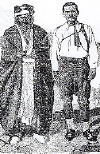
Sir Francis Bond Head was a soldier in the British army, who afterwards attempted to set up a mining company in Argentina. In 1825 Bond Head sailed for Buenos Aires with a group of Cornish miners. Under Bond Head’s guidance the miners rode across the Pampas, then crossed the Andes mountains and crossed into Chile, only to find that the promised mining concessions had in the meantime been granted to rival companies. Leaving his staff in relative safety, Bond Head rode back across the Andes alone, journeying to Buenos Aires for instructions. When it became evident that the mining proposal was doomed to failure, Bond Head rescued his men and oversaw their safe passage back to England. His subsequent book, “Rough Notes Taken during some rapid journeys across the pampas and Andes,” was produced in 1828 by the famous John Murray publishing house. Bond Head’s book was praised by his fellow English Long Rider, Charles Darwin, who had also made extended equestrian journeys in various parts of South America. In later life Bond Head was appointed Lieutenant-Governor of Upper Canada in 1836, where he was called upon to put down a rebellion. He later moved back to England, where he organised protests against the proposed outlawing of horse-riding in the area in which he lived.
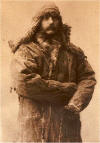
Gabriel Bonvalot – The annals of the Historical Long Riders include men and women of astounding bravery, remarkable resourcefulness and enduring optimism. Then there is Gabriel Bonvalot, whose remarkable rides “through the Heart of Asia” mark him as the most influential French Long Rider of the 19th century.
Bonvalot (1853-1933) was a French explorer, author, and legislator whose exploits in the saddle began in 1880 when he set out to explore Central Asia. Accompanied by the noted French scientist, Dr. Guillaume Capus, the intrepid French Long Riders explored the fabled kingdoms of Bukhara, Khiva and Samarkand. A few years later they once again rode across Central Asia, then turning southward, tried to penetrate into the hostile kingdom of Afghanistan. They were seized, imprisoned, then expelled back towards Samarkand. Refusing to concede defeat, Bonvalot determined to reach India via an obscure caravan track which reputedly ran across the Pamir and Hindu Kush mountains.
According to legend, this “Roof of the World” had been created when the Devil lifted the entangled mass of 20,000 foot high mountains to see what mysteries lay underneath. After a perilous winter passage, the Frenchmen managed to reach the remote mountain kingdom of Chitral. Instead of being hospitably received, they were again imprisoned as trespassers but, with the help of sympathetic British authorities, were eventually released and allowed to travel on to India. These two expeditions placed Bonvalot among the ranks of the English explorer Younghusband, the Russian explorer Prejevalsky and the Swedish explorer Hedin.
Yet these two journeys could be considered “training trips” for what came next.
In 1889 Bonvalot set out to make an unparalleled journey from France to French Indochina. Accompanying the seasoned equestrian explorer this time was Prince Henri d’Orleans, a young aristocrat with a craving for adventure and a talent for photography. After crossing Russia, the Frenchmen mounted up in Siberia, then headed south towards Tibet. The resultant equestrian winter journey across the Tibetan plain and the Himalayan mountains is nearly too arduous to believe. The men routinely rode in weather so cold that their Siberian companions begged them to turn back when the mercury in the thermometer froze.
Yet Bonvalot’s courage and resistance overcame all obstacles. “Our diet is always the same,” he wrote. “The frozen meat we chop with an ax. Our water is always dirty because its comes from melting ice. Tea never really boils on account of the altitude. The dust, mud, sand and hairs from our furs and beasts which we find in our food, are things which we have long ceased to pay attention to.”
On one occasion, as the illustration on the left demonstrates, Bonvalot's horse stumbled and nearly went hurtling over a 300-foot precipice with his rider. But Bonvalot carried coolly on. No doubt this terrifying scenario was repeated several times.
The French Long Rider needed to be tough, as not only the terrain, but also the xenophobic Tibetans, were trying to deter him. The government of Lhasa had a standing order to turn back any foreigners attempting to enter their “hermit kingdom.” But the observant Bonvalot was able to enter Tibet by following a trail considered so secret that many Tibetans did not even know of its existence. This attention to detail caused one caravan traveller to declare that even though he was a European, Bonvalot was certainly a “Saia.” When asked to explain, the wise traveller explained that a saia was a man who cannot stay in one place for long because “when our mothers were pregnant with us, they travelled, and as they strained their eyes to see beyond the horizons, they made us journeyers.”
Though Bonvalot and Prince Henri did indeed reach faraway Indochina, their most remarkable legacy is that they are the only Europeans known to have ridden the fabled meat-eating horses of Tibet. Due to a lack of grain and traditional forage, the Tibetans fed their horses on a special protein diet. Bonvalot noted, “We have had some small Tibetan horses given us which are full of go, and which feed on raw flesh, as we have seen with our own eyes. These carnivorous beasts have marvellous legs, are as clever as acrobats and carry us at a rapid trot.” Bonvalot’s observations form part of an important new research project currently being carried out by The Long Riders’ Guild Academic Foundation. The French Long Rider’s findings have been incorporated into a study of the hitherto undocumented use of carnivorous horses in cultures around the world.
Before his journey was over, Bonvalot had ridden across Siberia, the Takla Makan desert, Tibet and China, reaching Hanoi in little more than a year after setting off from Paris. This astonishing journey, which has never again been attempted, inspired Jules Verne to use Bonvalot as the role model of his intrepid fictional reporter, Claudius Bombarnac, who also travelled in this remote portion of the planet.
Yet Bonvalot’s ride was fact, not fantasy, and remains the record of the man who the natives said “was never happy unless he was seeking a fresh road.”
In admiration of this phenomenal equestrian explorer, The Long Riders’ Guild Press is preparing to re-publish Gabriel Bonvalot’s classic books, Through the Heart of Asia and Across Tibet. For further information on these exciting titles, please contact The Long Riders’ Guild.


Dennis Botterill made an epic ride across Australia in the 1970s.

Alastair Boyd - made many journeys on horseback through Southern Spain. Author of "The Road from Ronda".

William Brenchley - The death of South African Long Rider Billy Brenchley marked the sad end of an epic journey across Africa.
The Guild deals with hundreds of equestrian travellers, from all parts of the world. That's not to say that their trips are not important to them on a personal level.
But what Billy and his companion, Christy Henchie, attempted to do was Homeric in terms of its scope. The couple set off in 2005, determined to complete the first ride from the most northern point of Africa, Cap Blanc in Tunisia to the most southern point of Africa, Cape Agulhas in South Africa. Ten countries and an untold number of hardships awaited them.
They were detained in the Sahara desert for 75 days while the Libyan government debated whether to allow them to enter. Egypt, with its sandstorms, tick bite fever and heat waves proved difficult. After riding across Tunisia, Libya, Egypt and northern Sudan, Billy and Christy were halted by the impassable swamp known as the Sudd. If the equestrian explorers wanted to progress they would have to load their two horses onto one of the few remaining cargo barges and float south to the distant city of Juba. Their thousand mile nautical journey is unique among modern equestrian travellers. As they made their way through Southern Sudan, they passed areas where major battles had been fought. The landscape was littered with unexploded mines.
It was in Uganda that Christy and Billy made an astonishing discovery. Horses had disappeared from the country during the reign of Idi Amin. The unexpected sight of two Long Riders mounted on mysterious animals caused pandemonium in the countryside. They were followed by hundreds of curious people. Billy can be seen in the photo (above) speaking to a group of school children who asked, "Is that a kangaroo? Does it grow horns? Does it eat people?”
Soon after their arrival in Uganda, Billy became very ill. He was diagnosed with Acute Myeloid Leukaemia and immediately flown to South Africa for emergency treatment. After a lengthy sixteen month treatment, he and Christy returned to Uganda and resumed their journey, determined this time to reach South Africa.
The Long Riders had travelled into Tanzania when tragedy struck. In the worst accident in the history of modern equestrian travel, Christie, 29, was killed instantly on January 28 2013 by an out-of-control bus. Billy Brenchley, 43, escaped death by inches but suffered a broken leg.
A crowd of enthusiastic locals who had turned out to cheer the Long Riders past their village were also killed and injured by the reckless driver. Several were slain and twenty-five bystanders, including many small children, were brutally mown down by the speeding vehicle. Brenchley was later to report to the Long Riders Guild that the bus driver involved faced three counts of causing death and two counts of causing injury arising from the accident. He pleaded guilty and was fined 250,000 Tanzanian shillings – the equivalent of 1658.34 South African rand or just under $US154.
As soon as the Guild learned the news, it published this special report. That story was in turn printed by Horse Talk, the international equestrian news service, which spread the news round the world like wildfire. Within hours, Long Riders began sending in messages, registering their shock and loss. This in turn led to the creation of a special condolence document for Christie. When Long Riders from around the world heard about Christie Henchie's death, they rushed to send their heartfelt condolences.
Christie’s memorial service was held in South Africa, where the injured Billy had been flown in time to attend. But soon afterwards his leukaemia struck again. In emails to the Guild he explained that no matter how much time he had to spend in hospital, he was determined to regain his strength and finish the ride in honour of Christie. That desire was not to be. In February he rallied his strength enough to pay a final visit to see the couple’s horses. They have been cared for by friends in Tanzania. After seeing his horses a final time, Billy returned to South Africa where he died soon afterwards after a long battle with leukaemia.
Life is full of forgettable people, who fill the world and our lives with trivialities and trouble. A handful of us were blessed, for too short a time, to say we were enriched by knowing Billy and Christy. They were heroes on so many levels.
The author of Journey From the Arctic was apparently, as Voltaire put it, “A perfect Englishman – travelling without motive.” Yet Donald Brown had a deeply personal reason to ride by horseback from Lapland, through Sweden, into Norway during the winter of 1954. He believed that a journey on horseback was the most absorbing and eventful way to travel, a way to discover the world that becomes a mode not just of travel but of life.
There is an old saying among the equestrian journeyers of Central Asia that a unique occasion will produce a special man. When such a rare occasion arose in 1905 for a courageous horseman to ride from Kashmir to Peking, Major Clarence Dalrymple Bruce stepped into the saddle and cantered into Long Rider history. As the 20th century dawned this soldier turned author found himself on the wrong side of the Himalayas. Bruce had previously led a regiment of Chinese solders. Yet fate now placed him in picturesque Srinagar, Kashmir, thousands of miles away from faraway Peking where he wished to be. So Bruce did what any Long Rider would do – the impossible. He began by making his way to the mountain kingdom of Ladakh. There he enlisted a crew of “wild looking ruffians and 28 rugged ponies,” then set off on an eight-month journey that taxed men and horses to their limits. Mounted on his trusty 13 hand high Kashmiri pony, Bruce started by leading his caravan over 18,000 foot high Himalayan passes, before descending onto the Devil’s Plain in Tibet. The caravan was hard pressed to avoid detection by these xenophobic mountaineers who were adamant about keeping foreigners like Bruce out of their “forbidden kingdom.” They needn’t have bothered. Bruce had set his sights on Peking, thousands of kilometres away, so he wasn’t inclined to linger near Lhasa. From freezing in Tibet, Bruce next crossed into Chinese Turkistan. There he stood face to face with the infamous Lop Nor desert. It was in this dreaded wasteland, as they followed “in the hoofprints of Marco Polo,” that Bruce’s caravan suffered. Men collapsed. Ponies died. Yet they still rode towards mythical Peking. “The ponies never failed us, no matter how impossible the ground was,” Bruce recalled. In the Hoofprints of Marco Polo is that rare kind of book, one that reads as fresh today as it did the day Bruce set his pen to paper. Its pages are full of brave men and braver horses, wild mountains and picturesque tribesmen. Amply illustrated with photos taken by the author, this equestrian travel classic also contains an excellent appendix, complete with all of the author’s geographical observations.
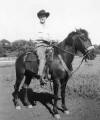
Tex Bunteen followed the call to adventure in 1939, when he decided to join his friend, Nick Beucher, on a 1400 mile journey from Texas to Mexico City.

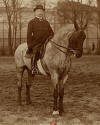
Evelyn Burnaby was the younger brother of the famous English Long Rider Colonel Frederick Burnaby. Whereas the elder brother was famous for having ridden across Central Asia and the Ottoman Empire, Evelyn decided to keep his equestrian adventures closer to home. He set off in 1892 to ride from Land’s End, Cornwall to John O’Groats, Scotland. Evelyn’s journey was soon serialised in a popular publication, “The Country Gentleman” and was published in book form the following year.
[This image does not actually portray the Historical Long Rider. It was chosen so as to demonstrate the clothes and type of horse used during this important journey. The Guild continues to search for a photo depicting the Long Rider and will publish it when found.]

The English
officer, explorer and gentleman, Colonel Frederick Burnaby, was so large and strong that he could carry a pony under each
arm. He was also courageous to the point of lunacy. He made two
remarkable journeys across Asia in the 1870s, after having almost
assuredly been influenced by the previous ride of Catherine de Bourboulon. Burnaby first rode across all of Central Asia, ending up at
the Amir's palace at Khiva. Then, after having avoided the Czar's spies
in Constantinople, Burnaby rode across all of Turkey. His books,
A Ride
to Khiva and
On Horseback through Asia Minor
are part of The Long Riders Literary Project. Baron
Yasumasa
Fukushima, the greatest Japanese Long Rider, was inspired to make his journey
from Berlin to Tokyo after having read Burnaby's books.
After surviving
these equestrian adventures, Burnaby led a contingent of English cavalry
against the Mahdi's troops in the Sudan. He died there from a spear
wound.
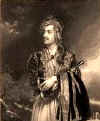
Lord Byron - explored the mountainous regions of Albania on horseback in 1809. Accompanying him was John Cam Hobhouse, who had attended Cambridge University with Byron. Albania had been a backwater satrap of the Ottoman Empire since 1478. Its hidden valleys were inhabited by fierce mountain tribesmen. Its few roads were infested with bandits. The country was ruled by a fierce despot. After a series of adventures, the Long Riders returned to England. Their Albanian journey inspired Byron to write his famous poem, "Childe Harold's Pilgrimage.” Though not as poetic, Hobhouse was an avid diary writer and it was his daily account entitled “Travels with Lord Byron,” that provides the details of their historic journey.
